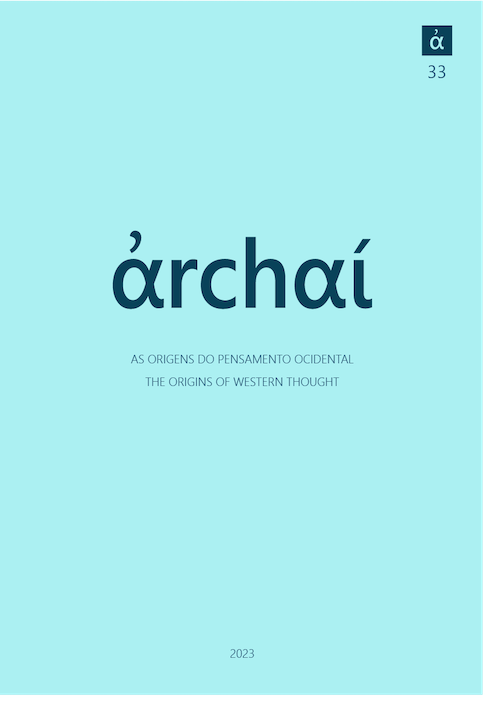The labyrinth technique in Aethiopica of Heliodorus
DOI:
https://doi.org/10.14195/1984-249X_33_27Keywords:
narrative techniques, hermeneutic, rhetoric, AethiopicaAbstract
Heliodorus is known for his elaborate narrative technique. This effect is due to ekphrasis, a resource widely used by sophists and recommended in textbooks of rhetoric (Progymnasmata). In the first block of the work, Heliodorus uses this resource, but not randomly. There is an image, literally or metaphorically repeating itself: the labyrinth. Our intention is to demonstrate that the repetitions have a commonality, in addition to a strong hermeneutical appeal. Moreover, the labyrinths are introduced in the part where the narrative is skillfully written in medias res. It is precisely in this passage that the reader, as in a labyrinth, is meanderingly led by several paths, until he reaches the understanding of the opening scene, at the mouth of the Nile. The analysis of the procedures used by Heliodorus leads to the conclusion that the succession of textual or imagethic labyrinths places the reader in a game, from which he can only emerge at the end of the fifth book.
Downloads
References
BARTSCH, S. (1989). Decoding the Ancient Novel: the reader and the role of description in Heliodorus and Achilles Tatius. Princeton: University Press.
EDSALL, M. (2002). Religious Narratives and Religious Themes in the Novels of Achilles Tatius and Heliodorus. In: PASCHALIS, M.; FRANGOUDILIS, S. (eds.), Space in the Ancient Novel, Groningen: Barkhuis Publishing & Groningen University Library, p. 114-133.
FUSILLO, M. (2009). Self-Reflexivity in ancient novel, Revue internationale de philosophie 2009/2, n. 248, p. 165-176.
FUTRE PINHEIRO, M. P. (1987). Estruturas Técnico-Narrativas nas Etiópicas de Heliodoro, Tese (Doutoramento em Literatura Grega), Universidade de Lisboa. 580 p.
FUTRE PINHEIRO, M. P. (1991). Fonctions du surnaturel dans les Étiopiques d’Héliodore, Bulletin de l’Association Guillaume Budé, 4, p. 359-381.
FUTRE PINHEIRO, M. P. (1994). Calasiris’ Story and its Narrative Significance in Heliodorus’ Aethiopica, Groningen Colloquia on the Novel, v. IV, p. 69-83.
FUTRE PINHEIRO, M. P. (2001). The language of silence in the ancient greek novel, in: S. Jäkel; A. Timonen (eds.), The language of silence. Turku : Yurun Yliopisto, v.1, p. 127-140.
FUTRE PINHEIRO, M. P. (2013). As Etiópicas de Heliodoro no contexto literário da segunda sofística. In: WEINHARDT, M. et alii (orgs.) Ética e estética nos estudos literários. Curitiba: Editora UFPR, p. 523-549.
FUTRE PINHEIRO, M. P. (2018). Thoughts on Diegema (Narratio) in ancient rethoric and in modern critical theory. In: CHEW, K.; MORGAN, J. R.; TRZASKOMA, S. (eds.), Literary Currents and Romantic Forms Essays in memory of Bryan Reardon, AncNarr Suppl. 26. Groningen: Barkhuis and Groningen University Library, p. 19-32.
GRAEBIN, G. S. (2022). As Etiópicas de Heliodoro: uma proposta hermenêutica. Tese (Doutoramento em Estudos Clássicos). Universidade de Lisboa. 363p.
KENNEDY, G.A. (2003) (trad.). Progymnasmata: greek text books of prose composition and rethoric. Atlanta: Society of Biblical Literature.
MAILLON, J. (trad.). (2011). HÉLIODORE. Théagène et Chariclée. Texte établi par R. M. Rattenbury, par 3 vol. Paris : Belles Lettres. (1960).
MORGAN, J. R. (2005). Le blanc e le noir: perspectives païennes et perspectives chrétiennes sur l’Éthiopie d’Héliodore. In: Lieux, décors et paysages de l’ancien roman des origines à Byzance. Actes de 2e colloque de Tours, 24-26 octobre 2002. Lyon: Maison de l’Orient et de la Méditerranée Jean Pouilloux, p. 309-318. (Collection de la Maison de l’Orient méditerranéen ancient. Série littéraire et philosophique, 34).
REARDON, B. P. (1991). The form of Greek romance. Princeton: University Press .
SANDY, G. (1982). Characterization and Philosophical Décor in Heliodorus’ Aethiopica, Transactions of the American Philological Association 112, p. 141-167.
SCHÄUBLIN, C. (2006). The Contribution of Rhetorics to Christian Hermeneutics. In: KANNENGIESSER, C. (org.), Handbook of Patristic Exegesis: the Bible in Ancient Christianity, p. 149-163.
WEBB, R. (1999). Ekphrasis ancient and modern: the invention of a genre. Word and image 15, n. 1, p. 7-18.
WEBB, R. (2018). La Galerie de tableaux de Philostrate: vision, mémoire et espace. In: BERTHOZ, A; SCHEID, J (org.). Les arts de la mémoire et les images mentales. Paris, Collège de France. p. 31-43.
WHITMARSH, T. (2001). Greek literature and the Roman Empire - the politics of imitation. Oxford: University Press.
WHITMARSH, T. (2005). The Second Sophistic Cambridge: University Press.
WINKLER, J. J. (1999). The mendacity of Kalasiris and the narrative strategy of Heliodoros’ Aithiopika In: SWAIN, S. (ed.) Oxford readings in the Greek novel, Oxford: University Press , p. 286-350.
Downloads
Published
How to Cite
Issue
Section
License
Copyright (c) 2023 Geruza de Souza Graebin

This work is licensed under a Creative Commons Attribution 4.0 International License.
Given the public access policy of the journal, the use of the published texts is free, with the obligation of recognizing the original authorship and the first publication in this journal. The authors of the published contributions are entirely and exclusively responsible for their contents.
1. The authors authorize the publication of the article in this journal.
2. The authors guarantee that the contribution is original, and take full responsibility for its content in case of impugnation by third parties.
3. The authors guarantee that the contribution is not under evaluation in another journal.
4. The authors keep the copyright and convey to the journal the right of first publication, the work being licensed under a Creative Commons Attribution License-BY.
5. The authors are allowed and stimulated to publicize and distribute their work on-line after the publication in the journal.
6. The authors of the approved works authorize the journal to distribute their content, after publication, for reproduction in content indexes, virtual libraries and similars.
7. The editors reserve the right to make adjustments to the text and to adequate the article to the editorial rules of the journal.



